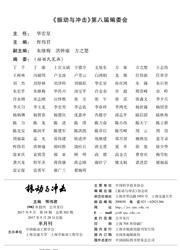

 中文摘要:
中文摘要:
土-结构相互作用是准确模拟核电厂结构、附着系统和组件地震响应的重要因素。使用振动台多功能叠层剪切土箱模拟土体边界条件,对某新型核电厂房进行1:25缩尺模型地震模拟振动台试验。试验选取10组水平加速度地震动记录,按照运行安全地震动(OBE)0.15g、极限安全地震动(SSE)0.30g和超设计基准地震动(ULE)0.75g作为输入,研究不同地震动强度引起的场地土非线性反应,以及对楼层加速度响应的影响规律;该模型土-结构相互作用振动台试验表明,尽管在基岩场地上,场地仍然对结构的地震效应造成明显的放大作用,在OBE、SSE和ULE工况下,场地动力效应放大倍数分别为3.13、2.1和1.19,由于土体逐渐进入了非线性状态,这种放大作用随着输入地震动强度的增强而变小。因此,建议对基岩场地的条件进行界定,并建议在任何条件下均需要考虑土-结构相互作用的影响,特别是在对核电厂设备、管道抗震设计和地震裕度评估时,不考虑土-结构相互作用将造成评估结果偏小。
 英文摘要:
英文摘要:
It is important to consider the soil-structure interaction for accurately simulating the seismic responses of the structures,subsidiary systems and components of nuclear power plants. A set of shaking table tests on a 1: 25 scaled nuclear power plant structure was presented,with the underlying soil simulated by using a multi-functional laminated shear container,by which the viscous-elastic boundary was well reproduced. A group of 10 ground motion records was taken as the input for the shaking table. The PGAs were scaled to the operational basis earthquake( OBE 0. 15g),the safely shutdown earthquake( SSE 0. 30g),and the ultimate earthquake beyond the design basis standard( ULE 0. 75g). The test results indicate that the plasticization is gradually developed in the soil with the increasing of input intensity. The soil nonlinearity exerts significant influence on the responses of the superstructure. The soil significantly amplifies the structural dynamic responses,although it is in a bedrock type site. The amplification factor is 3. 13,2. 1,and 1. 19 for the OBE,SSE,and ULE,respectively. It decreases with the increase of input seismic intensity,because of the plastification of the underlying soil. Therefore,it is suggested that the condition of bedrock site needs further evaluation,and at any type of site,the soil-structure interaction shall be considered,particularly for the seismic design and seismic margin analysis of facilities and pipes inside a nuclear power plant. Otherwise,the seismic margin will be underestimated.
 同期刊论文项目
同期刊论文项目
 同项目期刊论文
同项目期刊论文
 期刊信息
期刊信息
